Let’s say—hypothetically speaking—that for whatever unthinkable reason there are folks out there who are not in the mood to go to Bele Chere. I have it on the highest authority that such people do exist. I will not name names, nor will I explore the possible dubious nature of their motives. Instead, let us just accept their existence and realize that they, too, might need a dose of music in their lives, and if they don’t care to acquire such live and in person, perhaps offering up some alternative ideas wouldn’t be a bad thing.
I briefly considered pursuing an idea tossed out at me the other day by a reader—that I explore the realm of the concert film. One day, I may well undertake that idea, but I need to brush up on my concert films and music documentaries first. My knowledge in that area is less than it might be. My collection of such titles is slim to non-existent. And since it’s already Thursday morning, there’s simply no time to put this concept into practice.
In place of that daunting project (for now at least), I’m simply going to put forth some ideas for musical films that might enliven a non-Bele Chere weekend—and it can also be put to use to augment a weekend of Bele Chere-ing should one choose to do so. Some of the choices are going to be pretty predictable—though I’ve deliberately left off a couple of the usual suspects like Baz Luhrmann’s Moulin Rouge! (2001) and Julie Taymor’s Across the Universe (2007). Personally, I don’t think you can go wrong with either one, but for diversity’s sake, I’ll set them aside this weekend.
So is there any rhyme or reason to the selections? Yes and no. It’s simply a mix of musicals, but with an occasional eye toward the overlooked, the underappreciated or the just plain forgotten. I’ve put them in chronological order, which I find makes 1933 look like the year for musicals, but that’s mostly because at least two films from that year are sadly overlooked. The only strict criterion adhered to here is that all the titles have been released on DVD.
Love Me Tonight (1932). Rouben Mamoulian’s glorious Maurice Chevalier-Jeanette MacDonald musical comedy is a film that’s as close to perfect as you’re ever going to get. I picked a sequence of it a few weeks back for one of my “film clips in hell” choices, but only because I couldn’t pick the entire film. From the moment Mamoulian opens the movie with a sequence of building rhythms depicting the city of Paris (the Paris of Paramount Pictures, that is), it’s obvious that this is a unique film—and it doesn’t stop there.
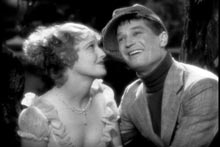
The creativity of the picture is unending. Every cinematic device imaginable is packed into this one movie—slow-motion, fast-motion, split-screen, model work, rhythmic cutting, double-exposures with two scenes playing at once, psychological use of camera angles, even an early use of the zoom lens. (If you wanted a teaching tool to show what movies are capable of, you could find it in this one film.) It’s simply an amazing outburst of a fusion of music and movie. And what music! You get not only such Rodgers and Hart standards as “Isn’t It Romantic?,” “Lover,” “Mimi” and “Love Me Tonight,” but a variety of other, less familiar delights—“How Are You?,” “The Song of Paree,” “The Son of a Gun Is Nothing But a Tailor” and the astounding theatre piece, “The Poor Apache.” Toss in a witty, sexy screenplay, a perfect cast (Myrna Loy as a nymphomaniac is a marvel) and solid production values and movies don’t get better.
Flying Down to Rio (1933). Famous as the first film to team Fred Astaire and Ginger Rogers, but unfairly dismissed owing to the fact that it boasts so little of them, Thornton Freeland’s Flying Down to Rio has charms of its own—if anyone bothers to look. Sure, the romantic leads—Dolores del Rio and Gene Raymond—are kind of bland (actually, I always find Raymond a little smarmy), but there are some pretty significant compensations.
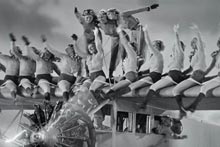
The film is clever and stylish, and the script is delightfully pre-Code (“Say, what have these South Americans got below the equator that we don’t?” asks a miffed American chorus girl). And, of course, there’s the bizarre “Flying Down to Rio” number with its chorus girls (some in surprisingly transparent blouses) on the wings of airplanes in flight. But then there are the songs by Vincent Youmans, Gus Kahn and Edward Eliscu—three of which are standouts, and all of which are done in a flat-out, heavy bass “hot jazz” manner that would soon be out of favor for smoother orchestrations. There’s not only the title song, but a pretty hot number, “Music Makes Me,” sung by Ginger Rogers and later danced to by Astaire. Best of all, however is “The Carioca.” Its general significance is given over to its status as the first dose of Fred and Ginger tripping the light fantastic (atop rotating grand pianos no less), but there’s also a terrific dance ensemble—their work enhanced by some breathless editing that really captures the rhythm of the song. More, there’s the transcendent wonderfulness of Etta Moten (identified solely as “The Colored Singer”) in one of her two onscreen appearances (the other is also from 1933, singing “Remember My Forgotten Man” in Golddiggers of 1933). She has only once scene. She comes out and sings “The Carioca” and then reprises it after a cutaway to the ensemble, but when she’s on the screen, she owns this movie. She is electric and you’ll never forget her.
Hallelujah, I’m a Bum! (1933). This may well be the most peculiar musical film of the 1930s (and if you’ve seen 1932’s The Phantom President with its rhyming dialogue, that’s saying something). I’m not sure exactly why director Lewis Milestone thought the world was just waiting for a musical made in the style of Sergei Eisenstein’s Soviet movies, but apparently he did, and this Al Jolson musical is the result. It’s not just the look of the film and its “dialectic” editing that smacks of the Soviets, but the movie is given over to some pretty strong communist sloganeering. This is mostly from down-on-his-luck silent film comic Harry Langdon as a street sweeper with a penchant for talking about the coming revolution and calling the mounted police in Central Park “Hoover’s cossacks.” But the whole film has an air of the proletariat about it—as well as a heavy aura of the Depression.
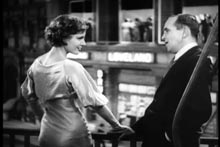
The movie’s unique in that it’s the only of Jolson’s films without a blackface number. In some ways, it’s the only Jolson picture in which he plays a character rather than simply an extension of his own personality. That’s both a good thing and bad thing, since Jolson constrained by a character doesn’t quite capture the sense of egotistical exubernance that made him a legend. Still, the film is fascinating—not always in a successful manner. You’ll probably always remember the schoolchildren singing “My Country ‘Tis of Thee” with a cut to a close-up of a different child (or teacher) on every word, but you’ll also likely wonder, “What were they thinking?”
At the same time, there are some great Rodgers and Hart songs (the boys were busy around this time) and some clever musical interpolations (more like rhymed dialogue set to music than actual songs). Two of the songs, “Hallelujah, I’m a Bum!” and “You Are Too Beautiful” have become standards. The former is done in a slightly strange style. Jolson strolls along singing it, but we only see his shadow and what the other hobos inhabiting Central Park are doing. The reason for this is more practical than artistic. The title and the lyrics of the song had to be changed for the British market (bum only means backside in the UK), so it was easier just to drop in a new soundtrack for the British print rather than shoot two versions of the song. “You Are Too Beautiful,” on the other hand represents one of the most iconic representations of the Depression with Jolson singing it to Madge Evans on a fire escape with people dancing in a cheap dancehall across the street.
Footlight Parade (1933). I’ve always found this Lloyd Bacon-Busby Berkeley picture a little overrated, but not badly so. And it certainly has much to recommend it. It’s blessed with one of those improbably risque pre-Code screenplays (when Joan Blondell throws duplicitous Claire Dodd out of her apartment in the middle of the night and the latter protests, Blondell merely tells her, “As long as there are sidewalks you’ll have a job”). It also has all the best Warner Bros. contract players at their best and it adds James Cagney to the mix. Most of all, though, it has the usual run of three very creative Berkeley musical numbers.

The first number, “Honeymoon Hotel,” is the weakest (it’s also the weakest of the songs), but it has its moments. However, it’s followed by the marvelous “By a Waterfall,” which may not be a particularly great showcase for Dick Powell and Ruby Keeler, but is one of Berkeley’s most stunning ensemble creations. This is followed by the magnificently loopy “Shanghai Lil,” as weird a concoction as the maestro ever dreamed up. It tells a little story of a sailor (Cagney standing in for the too-drunk-to-go-on juvenile lead) searching the bars and opium dens of Shanghai in search of his Shanghai Lil (Keeler). Both the drug angle and the occupations of the assorted chorus girls are surprisingly explicit, but they probably take a back-seat to Berkeley’s explosions of kitsch—as when the dancers form the NRA (National Recovery Administration) eagle and then put together a jigsaw puzzle of FDR’s face. Now, how do you top that?
Waikiki Wedding (1937). The always underrated Frank Tuttle made this rather unassuming Bing Crosby musical, which qualifies as one of the crooner’s best 1930s films. Bing plays a fairly unscrupulous—and very lazy—idea man for George Barbier’s pineapple company in Hawaii. Unfortunately for him—but fortunately for the plot—his latest idea, a “Pineapple Girl” contest, has run aground when it turns out that the winner, Shirley Ross (as always making you wonder why this lady didn’t have a better career), is unhappy and wants to go home because she’s not getting the romantic experience promised. As a result, Bing proceeds to give her what she’s after—even if it means creating a ridiculous adventure involving a sacred pearl and an angry volcano. Naturally, the two also fall in love—a fact complicated by Bing’s lies.
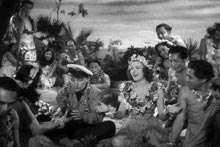
In terms of plot, the movie’s no great shakes, though Tuttle works in some clever social commentary on occasion as in a shot of “traditional” Hawaiian drum-playing dissolving to scene of locals toiling away stamping cans of pineapple in Barbier’s processing plant. But it’s agreeably lightweight stuff with some pleasant comedy and Bing gets to introduce “Sweet Leilani” and “Blue Hawaii,” along with other nice tunes like “Sweet Is the Word for You” (charmingly reprised by Ross) and “Noni Ona Pua.” Ross also gets her own song, “In a Little Hula Heaven.” And there’s Martha Raye cutting loose on “Okolehau,” which may be a matter of taste and one’s tolerance for the boisterous Raye.
A Hard Day’s Night (1964). Leaping forward to what may be described as the first modern musical there’s Richard Lester’s A Hard Day’s Night with the Beatles. I’m not sure that much can be said about this landmark film that hasn’t already been said (some of it by me), but no words can really do justice to this inventive, clever film with virtually no plot. To the degree that there’s a story at all it can be summed up in a sentence—the Beatles go to London to appear in a TV special. That’s it. And in truth, it isn’t really the Beatles—it’s everybody’s fantasy of the Beatles. Dressing it all in a seemingly unscripted (not really) style that smacks of documentary (it isn’t) gave the world the Beatles of myth—with occasional glimmers of truth as concerns the lads’ personalities. In the end, it’s a kind of documentary of that myth.
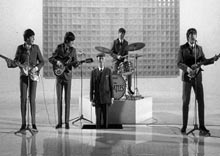
It’s also a joyous, exuberant collection of Beatle songs performed in a variety of ever-more-creative ways from the pleasant whimsy of “I Should Have Known Better” performed in a train’s luggage van to the ground-breaking antics of “Can’t Buy Me Love” to the pure Beatlemania of the performance of “She Loves You” at the film’s end. None of it’s real in any strict sense of the word, but its very unreality captures the essence of that moment in time in a way that leaves realism in its dust. And there are flashes of reality in the depiction of the audience at the end—some of it pretty telling, since it’s not hard to guess what just happened to the one girl who goes into an orgasmic shudder. It’s as fresh today as it was 44 years ago—and just as unassuming, which is the key to its genius.
A Funny Thing Happened on the Way to the Forum (1966). Richard Lester’s back with us here as he brings the exact same cinematic style to this film version of a hit Broadway show. Purists will complain (and, in fact, they frequently do) that a number of Stephen Sondheim’s songs got cut from the film version. But if you’re not a hardcore Sondheimian (and I’m not), it’s a deliriously manic musical film that certainly does right by the songs it does retain. It also affords Zero Mostel (from the stage show) the only film role—apart from Mel Brooks’ The Producers (1968)—that wholly takes advantage of his over-the-top personality. Too often on film Mostel simply overpowers everything else. Here, for a change, the film is fully as over-the-top as he is, and it’s a perfect match.
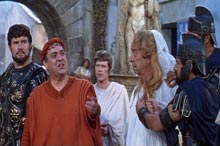
The same kind of wit and creativity that Lester brought to his stagings of the Beatle songs in A Hard Day’s Night and Help! (1965) is on display as he moves his characters around in an unrestrained manner and peppers everything with a kind of silent comedy sensibility that infuses the proceedings with throwaway sight gags. (It’s hardly coincidental that Lester brought silent screen comic Buster Keaton on board for what proves to be one of his best late-in-the-day performances.) If you’re in the mood for music mixed with outrageous slapstick—and a surprisingly earthy, almost raunchy screenplay (this is two years before the ratings system) —this is a film not to be missed.
Marat/Sade (1967). Now, here’s a strange choice. Peter Brook’s film version of Peter Weiss’ 1963 play The Persecution and Assassination of Jean-Paul Marat as Performed by the Inmates of the Asylum of Charenton Under the Direction of the Marquis de Sade (now you know why it’s always called Marat.Sade). It probably wouldn’t have occurred to me to include this had I not just seen the film preparatory to reviewing it for a showing next week. I’m glad I did, because it’s often forgotten that this bizarre, angry, intensely political work is in fact a musical. It may not be everybody’s idea of a musical, but it most certainly is one.
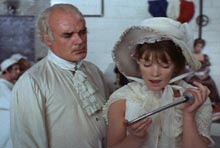
The film—which is essentially the Royal Shakespeare Company’s stage production brought to film—is as much something to be experienced as seen. It’s really an assault on your senses, and a good assault at that. What’s particularly powerful is that the events talked about are invariably excused as being “things of the past,” though the intention is clearly to comment on the present by way of association. Filmgoers will immediately recognize a very young Glenda Jackson as the narcoleptic inmate playing Charlotte Corday and Patrick Magee as the Marquis de Sade. The songs—music by Richard Peaslee—are an often surprising assortment of compositions. They range from the catchy and tuneful to the very edge of avant garde dissonance, but they all fit. And the results are impossible to dismiss.
Phantom of the Paradise (1974). Brian De Palma’s rock ‘n’ roll take on The Phantom of the Opera is actually one of the director’s best, most assured films—and a great little musical, too. (That it’s currently “in development” for a remake in 2010 is another matter.) De Palma regular William Finley gets his starring role break as Winslow Leach, composer of a rock opera that’s stolen by record magnate Swan (“He has no other name,” unbilled narrator Rod Serling tells us) played by pop composer/singer Paul Williams. Sent to prison on trumped-up drug charges, Winslow goes berserk and escapes, only to be seemingly killed after his face is burned in a record press. Of course, he isn’t dead at all, but sets himself up as the murderous Phantom lurking in Swan’s rock palace, the Paradise.
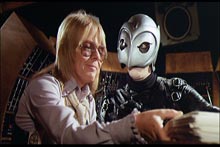
The musical chores for this cheerfully outre picture (for a PG rated film, it’s both surprisingly gross and sexual) were handed over to Williams, who approached the task by playing with a variety of musical styles. He created a Sha-na-na quality for “Goodbye, Eddie, Goodbye,” a Beach boys sound for “Upholstery” (“Carburetors, man, that’s what life is all about”), an Alice Cooper tone for “Life at Last,” etc. He took a more straightforward approach with the songs that were meant to be Winslow’s serious contributions before they were Swanned into pop pap-dom. The trick is that all the songs are good enough to pass muster as parody and as the real thing. No mean feat. Thematically, the film’s interesting, too, because it takes up the idea of a live coast-to-coast assassination on TV (“That’s entertainment!”) two years before Network got around to it.
The film pretty much tanked on its original release, but was briefly a mainstay on the midnight movie circuit till The Rocky Horror Picture Show (1975) came along and stole its thunder. It’s ripe for rediscovery—or for reacquainting yourself with it.
Tommy (1975). There was no way I wasn’t going to include Ken Russell’s Tommy. It may be a predictable choice, but really it’s still the cinematic rock opera—and with good reason. It took film to places film just hadn’t gone before—and it still comes across today. In some ways, it may come across even better today, because we can put it in perspective. When it came out in 1975, there was a tendency to approach it a little too reverentially—like it was a trip to church. (You see something like this right now with The Dark Knight.) And while it is a serious work with serious themes (a document and indictment of the modern age), it was also always intended to be fun. There’s a great deal of very funny—deliberately funny—material in the film. Enjoy it—this isn’t a sermon. (Well, yeah, it kind of is, but it’s not meant to be a dreary one.)
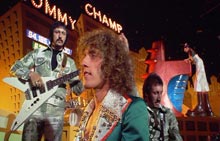
As a musical, you’ve got the Who in top form (Townshend’s exploring to same musical ideas as in the concurrently produced Quadrophenia album—compare the soundtrack to that rather the 1969 Tommy album). You’ve got Elton John from when he was still cool. There’s Tina Turner and Eric Clapton, too, There’s even a brief appearance by Arthur Brown. Yes, the lead roles—apart from Daltrey’s Tommy—are given over to non-rockers Ann-Margret and Oliver Reed, but they help to carry the film’s dramatic arc. And don’t tell me that Oliver Reed can’t sing. He can’t, but that’s part of the whole point—he sings the role Frank Hobbs in character. Go with it. As the ads said at the time, “Your senses will never be the same.”
Popeye (1980). It bombed in 1980 and wasn’t well-received by most critics—though both Roger Ebert and Andrew Sarris championed it. Time, however, has been very kind to Robert Altman’s Popeye. In fact, it can be seen now as one of his most accomplished works—deftly walking a narrow path between his own iconoclasm (a Popeye who hates spinach) and a faithfulness to the long-forgotten inconoclasm of the original material (before the character and his world were homogenized out of existence). That he succeeded is remarkable. (It’s even more remarkable in light of reports that the cast and crew were stoned most of the time the film was being made.) In this, he was helped to a great degree by Robin Williams before he became whatever it exactly is that he is today as Popeye and Shelley Duvall, who might have been born to play Olive Oyl.
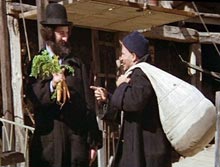
There’s also the matter of Harry Nilsson’s songs. Much despised at the time, these Nilsson-eque tunes have taken on a peculiar charm in the intervening years. It’s interesting to speculate on how much of this is due to Paul Thomas Anderson’s brilliant use of “He Needs Me” as the love theme for his Punch-Drunk Love (2002). Certainly, the film brought the song and Nilsson’s score back into our consciousness. In any case, the songs all these years later may not be particularly distinguished, but they have a quirky appeal. Sometimes having a true personality beats out being actually good—and that may be the case here.
Forbidden Zone (1980). I’ve saved the strangest for last. Richard Elfman (Danny Elfman’s big brother) made this outrageous assault on—well, just about everything you care to name for almost no money. The budget or lack of one shows in the film’s cardboard sets and crumpled paper caverns, but Elfman makes a virtue of it all by not attempting to make a single thing about the film realistic. What he ended up with was a kind of anything-to-shock musical phantasmagoria in the manner of a 1930s Max Fleischer cartoon. (There are several specific gags taken directly from Fleischer cartoons—notably Bimbo’s Initiation (1931)—and the presence of Cab Calloway on the soundtrack, not to mention Danny’s variation on “Minnie the Moocher” seal the deal.)
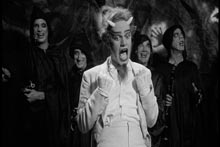
The tone of the film is established by the introductory title—“Huckleberry P. Jones, local pimp, narcotics peddler, and slum-lord, was seen entering a vacant house that he owned. While stashing some heroin in the basement, he stumbled upon a mysterious door. Naturally, he entered…” This is then followed by an outburst of terribly politically incorrect “Feets do your stuff” humor that plunges the viewer into the weird world of the film and the mysteries of “the Sixth Dimension,” which lies behind that door. That won’t prepare you for what happens, but it might give you an idea that Elfman is out to poke at your sensibilities. As Danny Elfman once said, both he and his brother take delight in “pissing people off.”
Actually, unless, you’re utterly humorless or easily offended, I can’t imagine being that appalled by the movie. I can easily understand hating it, but not being appalled. It’s all too exaggerated and bizarre and good-humored. It’s also full of songs—some by Danny’s rock group Oingo Boingo (then called “The Mystic Knights of the Oingo Boingo”). Danny himself shows up as Satan (who apparently also lives in the Sixth Dimension—located somewhere beneath Venice, California) and sings “Squeezit the Moocher.” The fantastic Susan Tyrell gets a song of her own, “Witch’s Egg,” while even Herve Villechaize warbles a little. Richard Elfman has a bit as a masseur who sings, “The Yiddishe Charleston,” too. Amazingly, for all its cheapness, some of the animation effects (by John Nelson, the senior effects adviser on a little picture called Iron Man) are stunning—like the entry into hell. You can love it, hate it, or simply sit back in slack-jawed wonder, but you’ll never see anything quite like it.




What, no love for “All That Jazz”?
What, no love for “All That Jazz”?
Not a whole lot, no. But it’s been 20-odd (and some downright peculiar) years and I really should revisit it.
I did mean to include Milos Forman’s Hair and John Cameron Mitchell’s Hedwig and the Angry Inch, but time ran out. I’d also personally include James Whale’s Show Boat and Ken Russell’s The Boy Friend, but neither is available on DVD.
What, too hip for Rodgers and Hammerstein?
Good piece, but there are some major omissions. Hairspray is good “get up and go” music, Chicago is great for jazz lovers and the very underappreciated Newsies is, in my opinion, among Alan Menken’s best work. Also good are Jesus Christ Superstar and Fiddler on the Roof, both directed by Norman Jewison.
What baffles me, though, is why no one has ever attempted to make the musical (more like an opera) Les Miserables into a film. You’d think it would be a natural, especially given the recent revival of musical films.
What, too hip for Rodgers and Hammerstein?
Well, if Show Boat (1936 version — accept no substitutes!) was on DVD, I’d have had Kern and Hammerstein. I’m not sure Im too “hip” for Rodgers and Hammerstein, but I’ve never found a film version of any of their work that I cared for that much. (I liked Flower Drum Song when it came out — I was 7.)
Good piece, but there are some major omissions
Well, it was never meant to be a definitive list. I will say that I prefer Waters’ Hairspray (which could qualify as a musical) to the musical version and that I like Chicago a little less with each passing year. I did toy with including Jesus Christ Superstar.
I’ve no clue why Les Miserables has never been filmed, but owing to the less than stellar box office of other operatic styled shows like Phantom and Sweeney Todd, I wouldn’t be holding my breath for it any time soon.
To reflect the spirit of Ken’s article, we really should be writing songs, not posts.
So in light of our banter about Rodgers and Hammerstein, I need some help writing “Ken Hanke” to the tune of “Edelweiss,” which I think was the last song Oscar Hammerstein ever wrote. (Hammerstein, by the way, the only Oscar ever to win an Oscar.)
Here’s what I’ve got so far:
Ken Hank-ee, Ken Hank-ee
Every Wednesday you greet me
Blank and blank, blank and blank
You look cranky to meet me…
Any ideas about four one-syllable adjectives that best describe Cranky Hanke and his reviews?
Any ideas about four one-syllable adjectives that best describe Cranky Hanke and his reviews?
And keep it clean.
There lies the rub.
To keep it relevant to our exchange, I tried starting the third line with “Not too hip,” but the only way I could think of finishing the line was with “full of …”
And I agree, we definitely need a G rating on this.
To keep it relevant to our exchange, I tried starting the third line with “Not too hip,” but the only way I could think of finishing the line was with “full of …”
Well, there’s always “full of it,” if you want to go that route. Or “grit,” but that hardly seems to fit, except in such instances as sitting through, say, Date Movie (that takes a certain amount of grit — or grim determination), or dealing with a degree of abuse when taking an unpopular stance.
maybe “no nitwit”
maybe “no nitwit”
I’m good with it, but others may argue the point.
One must always be wary of asking for lyrics. Back in 1935 RKO complained to Irving Berlin that his song, “The Piccolino,” for Top Hat was about a song and not a dance, Their previous big Astaire-Rogers numbers, “The Carioca” and “The Continental” had been about dances and they wanted more of the same. Berlin offered them this — “Come and do the Lido/It’s good for your libido.” The matter was quickly dropped.
Nothing that a little tinkering wouldn’t have resolved–say “Come and do the Lido/it’s party time in Toledo” or “Come and do the Lido/With buxom babes in Speedos.” Ahem.
Nothing that a little tinkering wouldn’t have resolved–say “Come and do the Lido/it’s party time in Toledo” or “Come and do the Lido/With buxom babes in Speedos.”
Citing Toledo in a movie taking place in Venice might be confusing and I don’t think they had Speedos back then. (Most people I see wearing them make me wish we didn’t have them now.)
All this suggests a good reason why you aren’t Irving Berlin. Him being dead is, of course, another one.